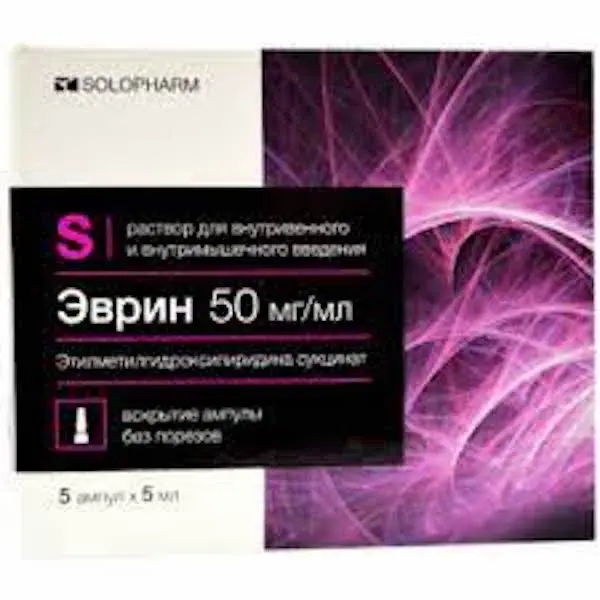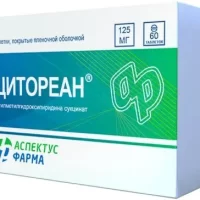Description
Evrin injections Pharmacodynamics
Ethylmethylhydroxypyridine succinate belongs to the class of 3-oxypyridines, and is an inhibitor of free-radical processes and a membrane protector. It also has an antihypoxic effect, increases the body’s resistance to stress.
The mechanism of action of ethylmethylhydroxypyridine succinate is due to its antioxidant and membrane-protective effect. The drug inhibits lipid peroxidation, increases superoxidase activity, increases the lipid-protein ratio, improves the structure and function of cell membranes.
Ethylmethylhydroxypyridine succinate models the activity of membrane-bound enzymes (calcium-independent phosphodiesterase, adenylate cyclase, acetylcholinesterase), receptor complexes (benzodiazepine, gamma-aminobutyrate, acetylcholine), which increases their binding ability to ligands, helps maintain the structural and functional organization of biomembranes, transport neurotransmitters and improve synaptic transmission. Ethylmethylhydroxypyridine succinate increases the content of dopamine in the brain. Causes enhancement of compensatory activation of aerobic glycolysis and reduction of the degree of inhibition of oxidative processes in the Krebs cycle under hypoxia with an increase in adenosine triphosphate (ATP) and creatine phosphate, activation of energy-synthesizing functions of mitochondria.
Increases the resistance of the organism to the effects of various damaging factors in pathological conditions (hypoxia and ischemia, cerebral circulation disorders, intoxication with ethanol and antipsychotic drugs).
Under conditions of critical reduction of coronary blood flow, it contributes to preservation of structural and functional organization of cardiomyocyte membranes, stimulates the activity of membrane enzymes – phosphodiesterase, adenylate cyclase, acetylcholinesterase. Supports acetylcholinesterase activation that develops in acute ischemia. Supports activation of aerobic glycolysis developing in acute ischemia and promotes under hypoxia restoration of mitochondrial redox processes, increases ATP and creatine phosphate synthesis. Ensures the integrity of morphological structures and physiological functions of ischemic myocardium. Improves the clinical course of myocardial infarction, increases the effectiveness of therapy, reduces the incidence of arrhythmias and intracardiac conduction abnormalities.
It normalizes metabolic processes in ischemic myocardium, increases antianginal activity of nitrates, improves rheological properties of blood, reduces consequences of reperfusion syndrome in acute coronary failure.
Contributes to the preservation of retinal ganglion cells and optic nerve fibers in progressive neuropathy caused by chronic ischemia and hypoxia. Improves functional activity of the retina and optic nerve, increasing visual acuity.
Reduces enzymatic toxemia and endogenous intoxication in acute pancreatitis.
Improves metabolism and blood supply to the brain, microcirculation and blood rheology, reduces platelet aggregation. It stabilizes blood cell membranes (erythrocytes and platelets), reducing the likelihood of hemolysis. It has hypolipidemic effect due to reduction of total cholesterol and low-density lipoproteins.
- Intramuscularly or intravenously (by stream or drop). During infusion method of administration the drug should be diluted in 0.9% sodium chloride solution.
- Doses shall be selected individually.
- The drug shall be administered slowly for 5-7 minutes by jetting, by drip infusion at a rate of 40-60 drops per minute. Maximum daily dose should not exceed 1200 mg.
- In acute cerebral circulation disorders it is used in combination therapy in the first 10-14 days – intravenously by 200-500 mg drip 2-4 times daily, then intramuscularly by 200-250 mg 2-3 times daily for 2 weeks.
- In case of craniocerebral trauma and after-effects of trauma, the drug is used for 10-15 days by intravenous drip 200-500 mg 2-4 times daily.
- In patients with discirculatory encephalopathy in decompensation phase the drug is administered intravenously by jet or dropwise in a dose of 200-500 mg 1-2 times daily during 14 days. Then intramuscularly 100-250 mg per day for the next two weeks.
- For course prophylaxis of dyscirculatory encephalopathy is administered intramuscularly in a dose of 200-250 mg 2 times a day for 10-14 days.
- For neurocirculatory dystonia, neurotic and neurosis-like conditions, the drug is administered intramuscularly 50-400 mg per day for 14 days.
- In mild cognitive disorders in elderly patients and in anxiety disorders, the drug is administered intramuscularly in a dose of 100-300 mg per day for 14-30 days.
- In acute myocardial infarction, as part of complex therapy, the drug is administered intravenously or intramuscularly for 14 days against standard therapy of myocardial infarction (including nitrates, beta-adrenoblockers, angiotensin-converting enzyme (ACE) inhibitors, thrombolytics, anticoagulants and antiaggregants, and symptomatic agents as indicated). In the first 5 days, to achieve maximum effect, the drug is administered intravenously, in the next 9 days the drug may be administered intramuscularly. The drug is administered intravenously by drop infusion, slowly (to avoid side effects) for 30-90 minutes (in 100-150 ml of 0.9% sodium chloride solution or 5% dextrose (glucose) solution), if necessary, slow trickle administration of the drug for at least 5 minutes is possible. The drug is administered (intravenously or intramuscularly) 3 times a day every 8 hours. The daily dose is 6-9 mg/kg of body weight, the single dose is 2-3 mg/kg of body weight. The maximum daily dose should not exceed 800 mg, a single dose – 250 mg.
- In open-angle glaucoma of various stages administered intramuscularly 100-300 mg per day, 1-3 times a day for 14 days as part of complex therapy.
- In withdrawal alcohol syndrome the drug is administered intramuscularly or intravenously in a dose of 200-500 mg 2-3 times a day for 5-7 days.
- In acute intoxication with antipsychotic drugs the drug is administered intravenously in a dose of 200-500 mg per day for 7-14 days.
- In acute pyo-inflammatory processes of abdominal cavity (acute necrotizing pancreatitis, peritonitis) the drug is prescribed during the first day both in preoperative and postoperative periods. Administered doses depend on the form and severity of the disease, process prevalence, variants of the clinical course. The drug shall be withdrawn only after stable positive clinical and laboratory effect.
- In acute edematous (interstitial) pancreatitis the drug is prescribed 200-500 mg 3 times daily, intravenously by drip (in 0.9% sodium chloride solution) and intramuscularly.
- Mild degree of necrotic pancreatitis – 100-200 mg three times a day, intravenously by drip (in 0.9% sodium chloride solution) and intramuscularly. Moderate severity – 200 mg 3 times a day, intravenously drip (in 0.9% sodium chloride solution). A severe course – in a dosage of 800 mg during the first day, twice a day; then 200-500 mg twice a day with a gradual reduction of the daily dose. Extremely severe course – in initial dosage of 800 mg daily until stable relief of pancreatogenic shock; after stabilization, 300-500 mg 2 times daily by intravenous drip (in 0.9 % sodium chloride solution) with gradual reduction of daily dosage.


